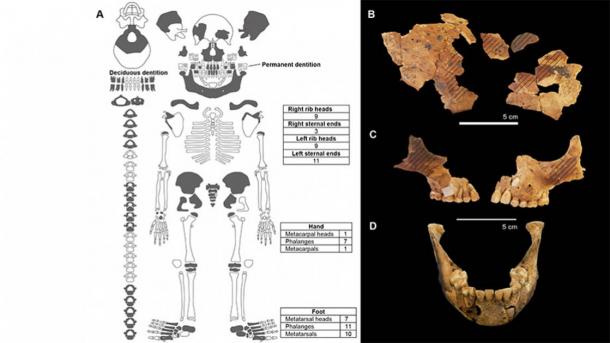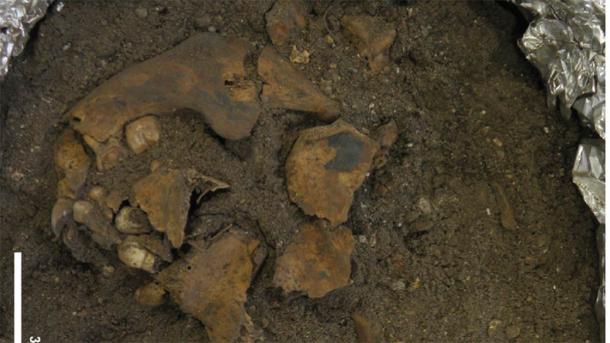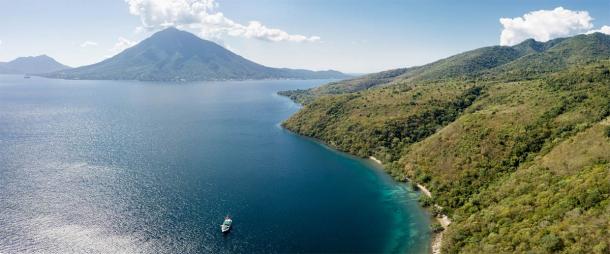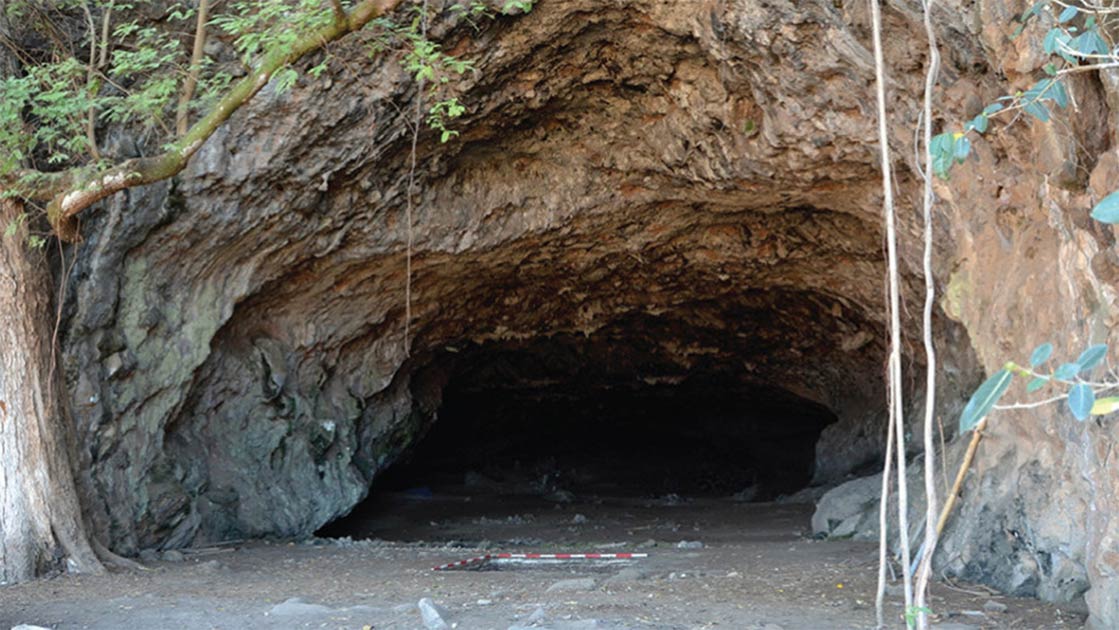8,000-Year-Old Child Remains Discovered With No Limbs
An 8,000-year-old ritual child burial is completing the currently shadowy picture of how ancient people dealt with death. On the outlying island of Alor, in the eastern Lesser Sunda Islands that run through southeastern Indonesia, researchers from the Australian National University (ANU) recently unearthed the 8,000-year-old child remains within Makpan Cave. ANU has dubbed this exceptionally rare discovery “a one-of-its-kind burial.”

Child remains have been discovered at Makpan Cave on Alor Island in Indonesia. Left: The skeletal elements in dark grey have been documented from the burial. Right: The reconstruction of sub-adult frontal bone. The diagonal lines show the location where ochre pigment was found. (Dr. Sofia Samper Carro / ANU)
Game On! Opening Up a Whole New World of Research
Dating to the early mid-Holocene, the child was “ritually buried” and this offers important insights into ancient burial practices, about which so little is currently known. An article on PHYS quotes the lead researcher Dr. Sofia Samper Carro as saying that the child was between four and eight years old when it was laid to rest "with some kind of ceremony.”
- 17,000-Year-Old Skulls Discovered On Migration ‘Highway To Oz’
- 'Vampire Burial' An Effort to Prevent a Child's Infectious Return from the Grave
- Experts Still Stumped By Child Buried With A Bird In Its Mouth
The evidence for “ritual” was threefold: the child's arm and leg bones were removed before interment, red ochre pigment was discovered on the child’s face, and an ochre-colored cobble stone was discovered beneath its head. With such a rare discovery, dating back 8,000 years, it’s now “game on,” because an entirely new field of research has opened up.

The child remains discovered at Makpan Cave on Alor Island in Indonesia included a fragmented mandible and cranial vault. (Tahlia Stewart / ANU)
A Rare Discovery That Changes Everything
As scanning technologies advance, so too does the discovery of rare ritual child burials. In 2015 Live Science reported on what was described as “a grim discovery” in a prehistoric cemetery in Irkutsk, a Russian city near the southern tip of Lake Baikal in Siberia. In this particular case, the grave of a young mother was discovered alongside her twins and analysis revealed that all three had died during a tragic childbirth about 7,700 years ago.
The child remains of “ritually buried” children have been found dating from around 3,000 BC in the Neolithic period. However, Dr. Samper Carro says nothing like this has been discovered from the early Holocene period. Furthermore, until now, it was unclear if, or how, deceased children were dealt with. “This find will change that,” states the researcher in PHYS.

An ochre-colored cobble stone was discovered beneath the head of the child remains discovered in the context of what appears to be a ritual burial. The image shows detail of the cobble located below the fragmented cranial vault. (Tahlia Stewart / ANU)
Understanding Paleo-Health is Key
The child's arm and leg bones were removed before interment and they must have been disposed of away from the burial site as they have not been found. Other contemporary burials in which the deceased were found with no limbs have been discovered in Java, Borneo and Flores, but according to Dr. Samper Carro “this is the first time we have seen it in a child's burial,” anywhere.
The child’s teeth initially caused the team of scientists to estimate that it had been at least six years old at death. However, when the skeleton was analyzed it was revealed that it belonged to “a four to five-year-old child.” In their quest to find answers for this mismatch, the team must conduct further research into “paleo-health.” Their conclusions were not caused by oversized teeth, but the suspicion is that the smaller skeleton was caused “by diet, the environment, or maybe being genetically isolated on an island,” Samper Carro explains.
A Deceased Child Prepared for a Voyage
Another size anomaly presented itself with the analysis of the child remains in that the child’s skull was smaller than would be expected for its age. This takes us back to another ANU paper published in August 2019 in which Samper Carro looked at two skulls discovered on Alor island dating back to some time between 12,000 and 17,000 years ago.
Regarded as “the oldest human remains ever found in Wallacea,” the island group between Java, Papua New Guinea and Australia, during the course of the project the scientist found that “adult skulls on Alor were also small.” Concluding that “small skulls point to a human migration highway to Australia,” the researcher thinks that the hunter-gatherers ate an almost 100% marine diet and that this caused a protein saturation leading to symptoms of malnourishment, which in turn could have affected growth.

The child remains were discovered on Alor Island in southeastern Indonesia. Researcher Dr. Sofia Samper Carro has argued that hunter-gatherers here ate an almost 100% marine diet which could have affected growth. (ead72 / Adobe Stock)
The researcher is a trailblazer who has committed a lifetime to understanding the emergence of civilization in early Asia. Now, with this new discovery of child remains, her goal is to create an accurate chronological chart of the evolution of ritual burial practices in this area between 12,000 to 7,000 years ago. But what this ritually buried child means to us Ancient Originites, is that like the discovery of Göbekli Tepe in the Southeastern Anatolia Region of Turkey, spiritual and religious thinking certainly did not emerge with agriculture.
Whoever performed this ritual burial, removed the child’s arms and legs, painted its face red and then carefully raised its head on a stone, believed that the remaining part of that child was going somewhere else. Care, concern and the use of color in the burial of these child remains, or any corpse for that matter, is perhaps evidence of preparation for a journey in which ones arms and legs would be of no use whatsoever.
 Through the catacombs and boneyards we build for our dead ancestors, we foster a type of immortality. Although human remains do not last forever, we can still view ancient burial chambers, catacombs, cemeteries crypts, and other places of the dead, giving insight into the living past. Visit where the dead rest and discover the secrets now with this Ancient Origins special production available here.
Through the catacombs and boneyards we build for our dead ancestors, we foster a type of immortality. Although human remains do not last forever, we can still view ancient burial chambers, catacombs, cemeteries crypts, and other places of the dead, giving insight into the living past. Visit where the dead rest and discover the secrets now with this Ancient Origins special production available here.
Top image: Entrance to Makpan Cave on Alor Island, where the child remains were discovered in the context of a ritual burial. Source: Dr. Shimona Kealy / ANU
By Ashley Cowie



















